NISSAN SERENA 1993 Service Repair Manual
Manufacturer: NISSAN, Model Year: 1993, Model line: SERENA, Model: NISSAN SERENA 1993Pages: 1254, PDF Size: 89.68 MB
Page 1121 of 1254
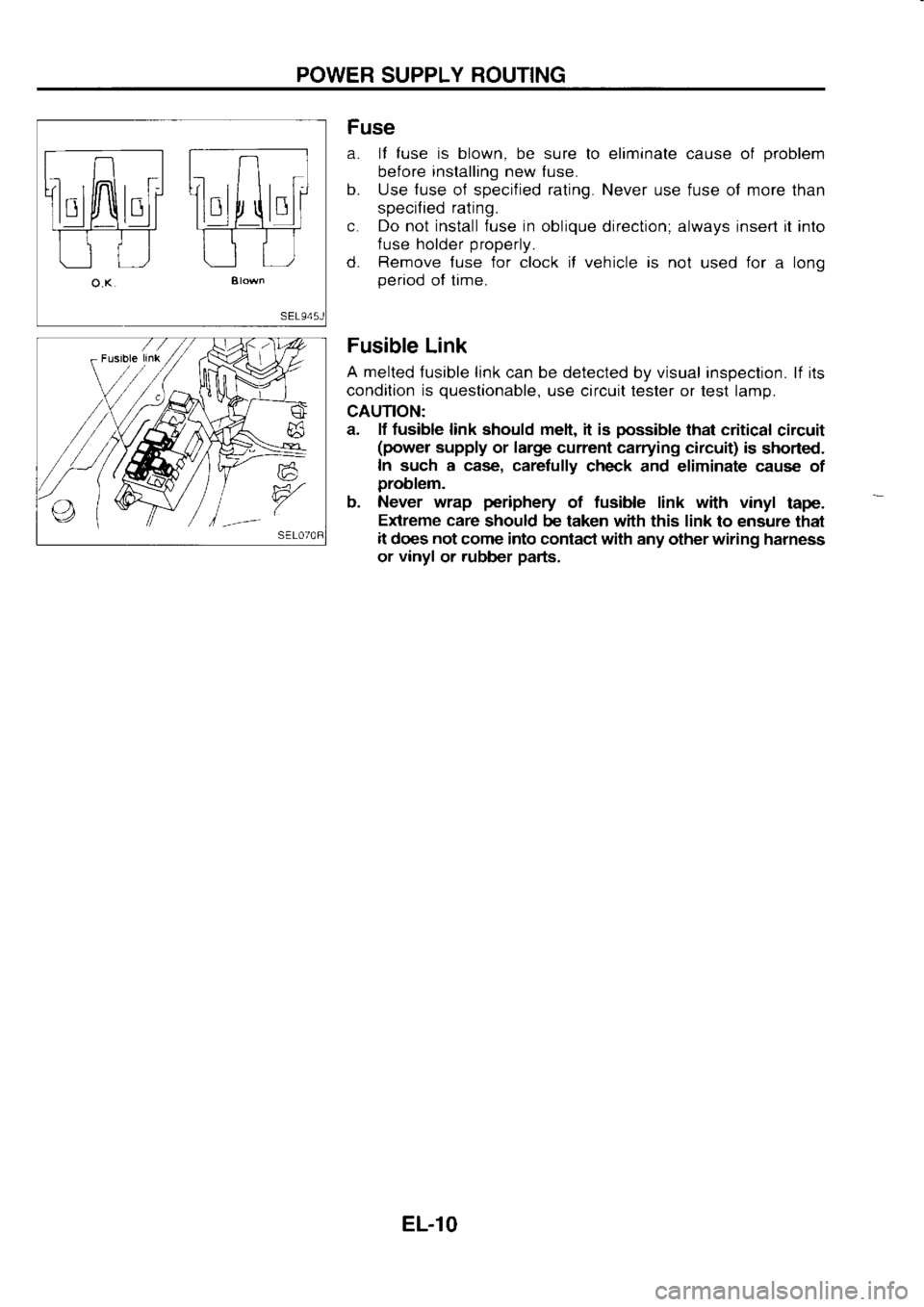
POWER
SUPPLY ROUTING
Fuse
a. It fuse is blown,
be sure to eliminate cause of problem
before installing
new fuse.
b. Use fuse
of specified rating.
Never use fuse of more than
specified rating.
c. Do not install fuse in
oblique direction; always insert it into
luse holder properly.
d. Remove fuse lor clock if vehicle is not
used for
a lono
period of time.
Fusible Link
A melted
fusible link can be detected
by visual
inspection.
lf its
condition is questionable,
use circuit tester or
test lamp.
CAUTION:
a. ll lusible link should melt, it
is possible
that critical
circuit
(power supply or large
current carrying
circuit) is
shorted.
In such a case, carefully
check and eliminate cause of
problem.
b. Never wrap periphery
of fusible link with vinyl
tape.
Extreme care
should be taken with this link
to ensure that
it does not
come into contact with any
other wiring
harness
or vinyl
or rubber pans.
EL-l0
Page 1122 of 1254
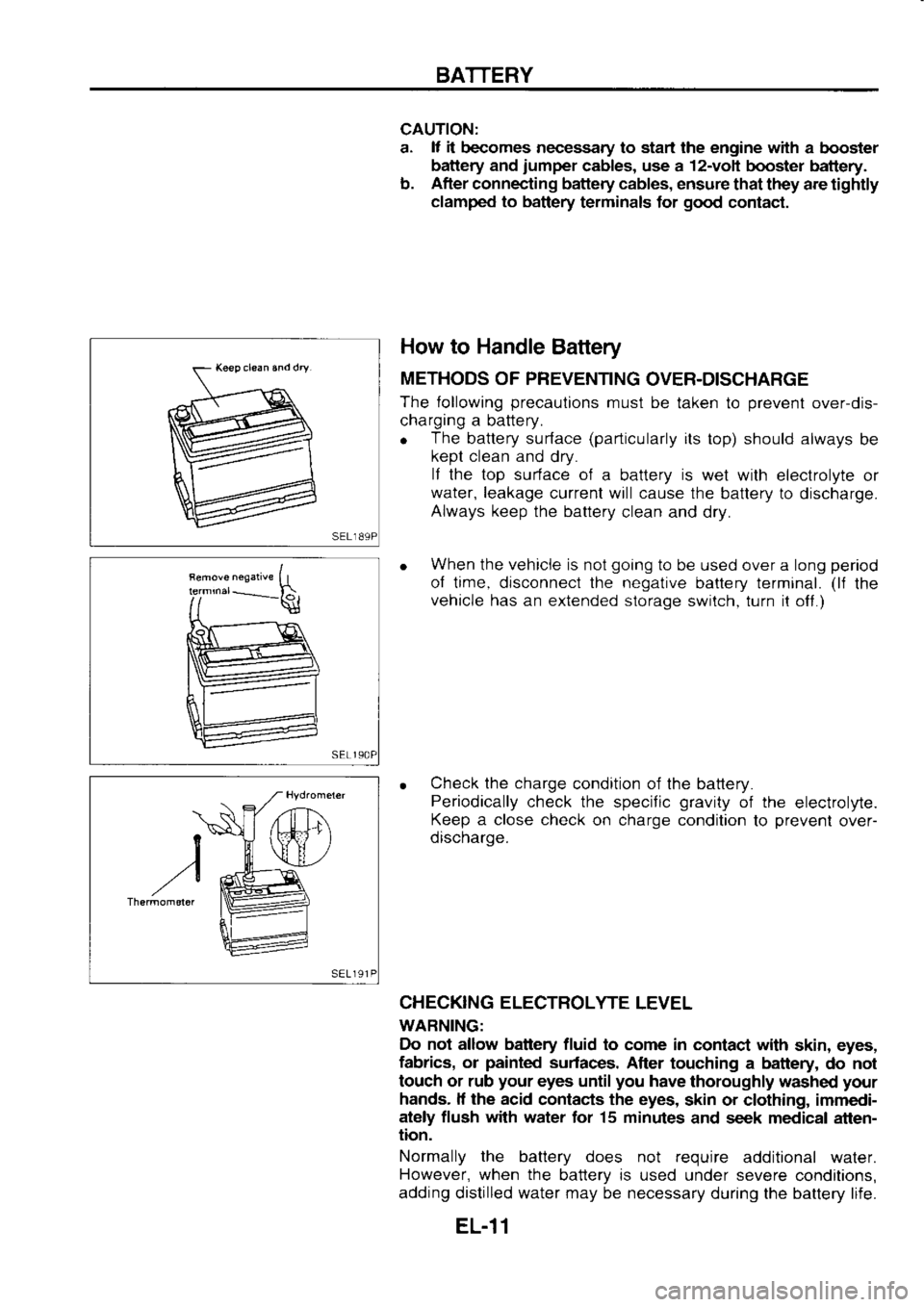
BATTERY
CAUTION:
a. lf
it
becomes neoessary to start the engine with
a booster
battery and jumper
cables, use a 12-volt
booster battery.
b. After
connec-ting battery cables,
ensure that they are tightly
clamped to batlery
terminals lor good
contact.
How to Handle
Battery
METHODS OF PREVENTING
OVER-DISCHARGE
The following precaulions
must be
taken to prevent
overdis-
charging a battery.
o The
battery surface (particularly
ils top) should always
be
kept clean and
dry.
lf the top surface of
a battery is
wet wilh electrolyte
or
water, leakage
current will cause the
battery to discharge.
Always keep
the battery
clean and dry.
When the vehicle is not going
to be used over a long period
ol time, disconnect the negative
battery terminal. (ll
the
vehicle has an extended storage
switch, turn it off.)
Check the charge
condition of the battery.
Periodically check the
specific gravity
of the
electrolyte.
Keep a close check
on charge condition
to prevent
over-
discharge.
CHECKING ELECTROLYTE
LEVEL
WARNING: Do not allow battery fluid
to come in contact with
skin, eyes,
fabrics, or painted
surfaces, After touching a
battery, do not
touch or rub your
eyes until you
have thoroughly washed your
hands. lf the
acid contacts the eyes,
skin or clothing, immedi-
ately flush with
water for 15 minutes
and seek medical atten-
tion.
Normally the
battery does not require
additional water.
However, when the
battery is used under severe
condilions,
adding distilled water may be necessary
during the battery life.
sEL
191
t
)
,r/ "
EL-11
Page 1123 of 1254
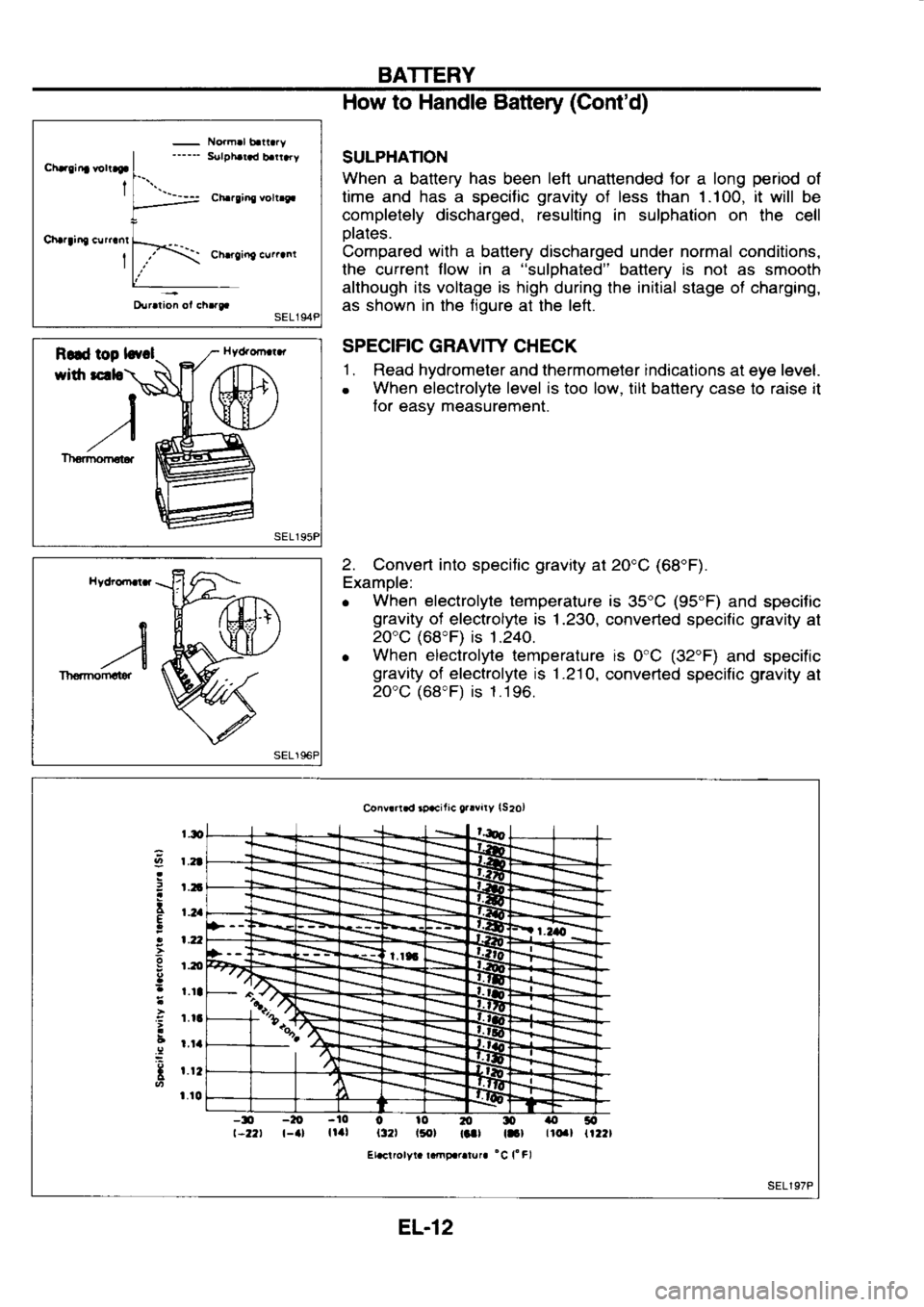
BATTERY
- No.mal
batia.y
____- S{rloharad b.riarv
Chrti't| volrrt
I
Charting csr..nr
I "_j:=
Ch.rginf Yolt.g.
Ch|rgin' curr.nl
Ogr.rion ol ch.rt How
to Handle Battery (Cont'd)
SULPHATION
When a baftery has
been left
unattended for a long period
of
time and has a specific gravity
ot less than 1.100, it will
be
completely discharged, resulting in sulphation on
the cell
plates.
Compared with a battery discharged under normal conditions,
the current flow in a "sulphated"
battery is not as smooth
although its voltage is high
during the initial
stage of charging,
as shown in
the figure
at the left.
SPECIFIC GRAV]TY CHECK
1 . Read hydrometer and thermometer indications
at eye level.
o When
electrolyte level is
too low,
tilt battery case to raise it
for easy measurement.
2. Convert into
specitic gravity
at 20'C (68"F).
Examole:
o When
electrolyte temperature is
35"C (95'F)
and specific
gravity of electrolyte is 1 .230, converted specific gravity
at
20'C (68'F)
is 1.240.
o When
electrolyte
temperalure is
0"C (32"F)
and specific
gravity of electrolyte is 1 .210,
converted specific gravity
at
20'C (68'F)
is 1 .196.
Rad
top Lvcl
with rcalc
)
Th6rmorn€t6a
Hydro.n t.r
e U
,-a
,rt a
Thsmoniatea
Conwrr.d !p.citic
er.vny (S20)
t
a t.$
|.2t
r.2t t.2a
l.z,
1.20 r.ta
t.ta
t.ta
t.t2
r.ro
||al t32t t50]
tat| tr]
Elactrolvta latnoaratura 'C
fF,
SEL197P
EL.l2
Page 1124 of 1254
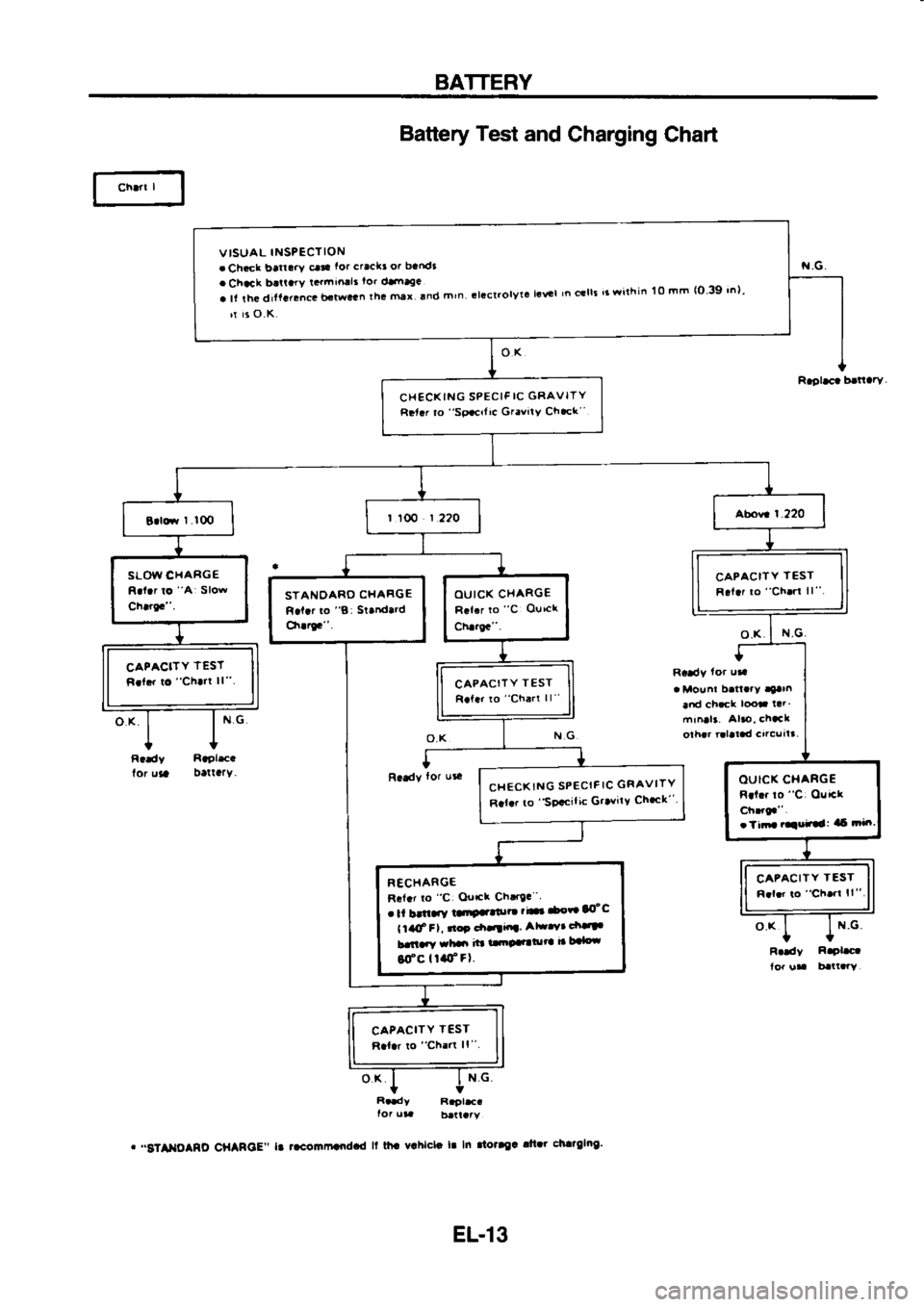
BATTERY
Battery Test
and Charging Chart
o.K
o.K. N.G Rcady
tot
ura
. Mount batlary .earn
a.id ch.ck loot
lar'
mrnalt. Alao, chack
orhar r.latad o.curlt
o.K.
N,G.
o.K R.9l.cr
bfiarY.
N.G,
N,G
Radv lor ura Ra9l.c.
battary.
R.-vRtlact
N.G.
R..dy R.pl.E.
tor uat
br(arv
. 'STAIIDARO
CHABOE" la
..conmandad ll
th. vahlcla l.
In ttot'g"tltr ch"g|ng'
V
ISUAL INSPECTION
.Chcct batary cata lor
crack! or bat'tdt
. Chack ballary
t.rmrnalt tor
ctnagc
.|lthcditf.rlnc.b.tw.cnth.maxrndmlh.G|!ct.o|ytc|.*||nct||t'rwnhinl0mm(o-39inl. rt rs
O.K
CHECK ING
SPECIF IC
GRAVITY
Rrl.. ro 'Sp.cilic
Gr.v(y Ch.ck"
CAPACITY T€ST
R.l.r to
"Ch.rl ll '
SLOW
CXARGE
R.l.r to 'Ar
slow
Ch.rg.'. OUICK
CHARG€
Ft.l.r lo 'C
Ou|ck
Ch..ga".
STANOARO
CHARGE
R.l.r to
"B: St.ndard
c,r.rF .
CAPACITY T€ST
R.lcr to "Chart ll
CAPACITY TEST
R.{.. io "Ch..l
ll
OUICK CHARGE
Rrl.. !o "C:
Ouicl
Chrrta"
. tiir tlu-td: ta6
tri|r.
CH€CK
ING
SPCCIF IC
GRAVITY
R.l.r to "sgacilic
GravilY Ch'ck"
RECHARGE
Rclcr to 'Cr
Ourcl Ch.tg. .
. tt btna.Y |rtFa.aol?t ri-
-cvt 'dC
t rad
F
l, rrog dr4i.r.. Alt.v. clr'{'
b.rtaw th-r
in |.|rF?atuna i.
b'lot
8dC fiadFl. CAPACITY
TEST
n.1.. ro "Ch..r
ll
CAPACITY TEST
R.t.r to "Ch.n ll
EL.13
Page 1125 of 1254
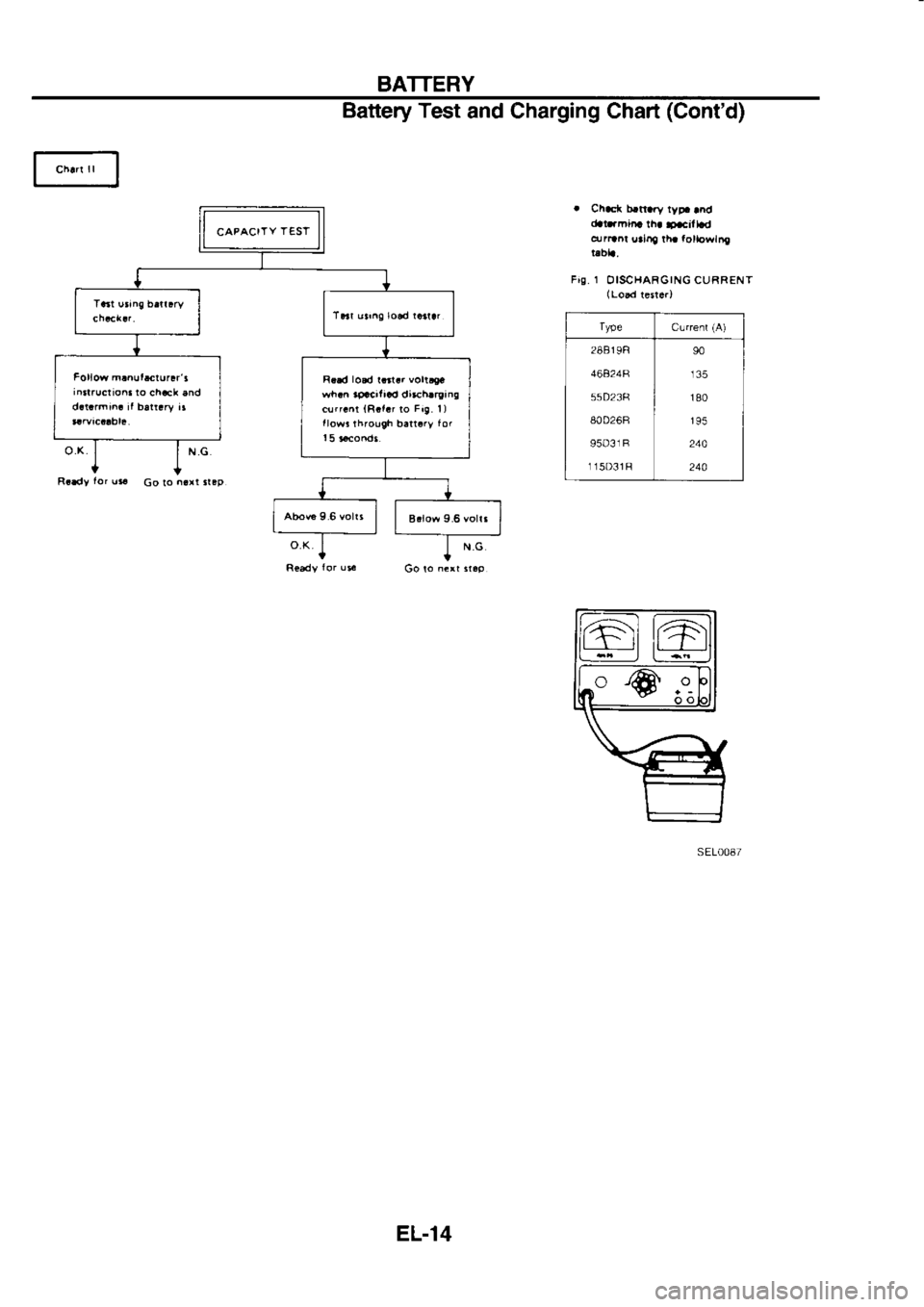
BATTERY
Battery Test
and Charging Chart (Cont'd)
. Chd( b.nary
ryp. rnd
cb!.rmina th. F.cilLd
drrnnr urlllo rh. lolbwtnl
tab|.,
Fig. 1
OISCHARGING CURRENT
(Lo.d re5t6r)
cuiienr (A)
28819R
46824A
55D23R
80D268
95D31R
I15D31R 90
180 195
244
244
Tatr
ul|ng load taata.
Follow mrnut.crur!r'r
inrtrudion. io chck and
d.t.rmr^G rl ba[ary il Rrrd
losd
lrrtr. volt46
wh.n .p.citi.d dirch.rging
curr.ni {Fl.l.r ro Fi9.
I )
llow3 rhrough bait.ry lor
R..dy tor
u..
Go to nlri
ittp
EL-14
Page 1126 of 1254
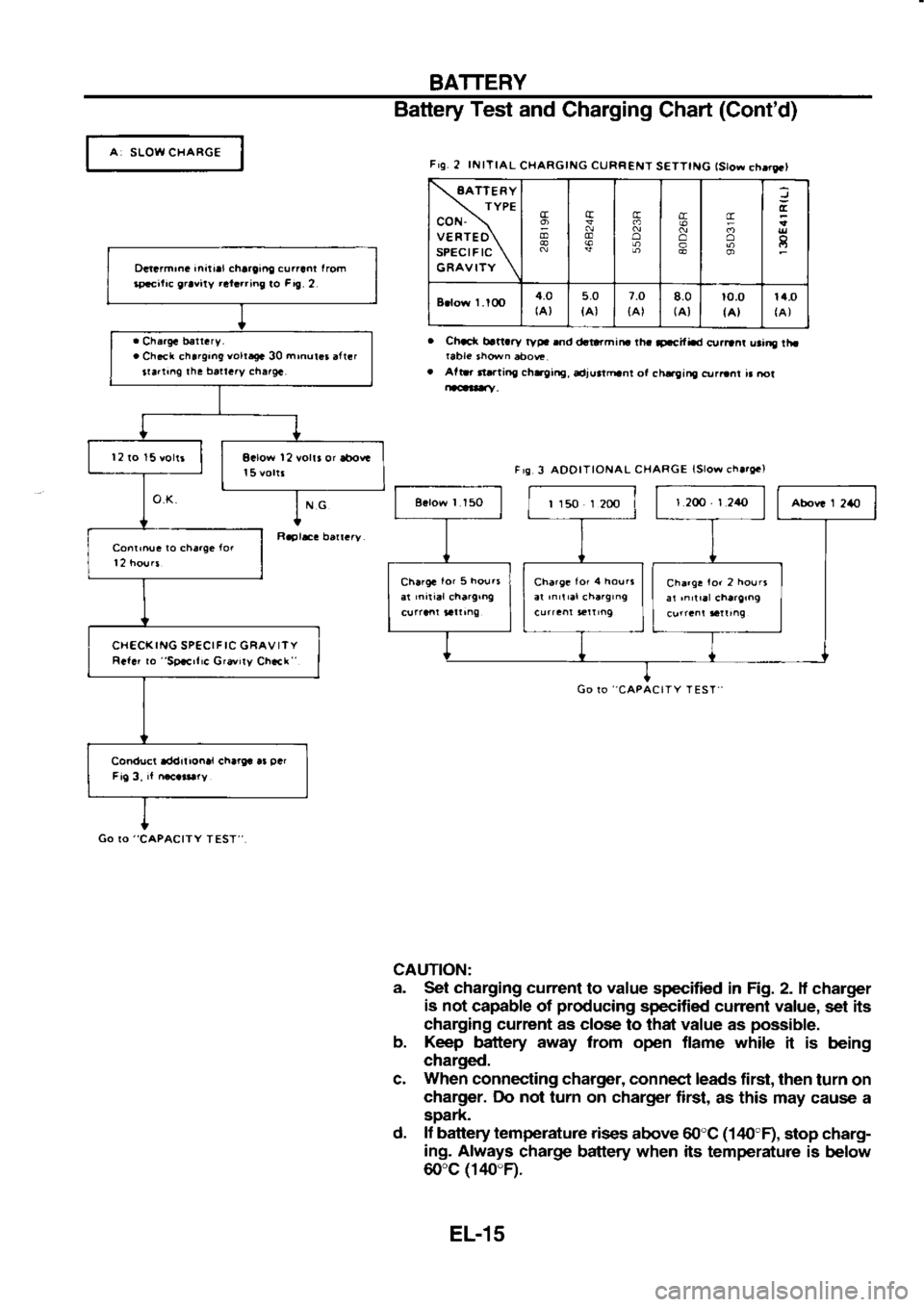
BATTERY
A SLOW CHARGE Battery
Test
and Charging Chart (Cont'd)
F19. 2 lNlTlAL
CHARGING CURRENT
S€TT|NG lstow ch.rg.,
\8ATTERY TYPE
coN- \
VERTEO\
SPEC|F tC
\
GRAVITY \c!
t! tr
(D cc
o cc
o cc
o ft
Bdow I
.l0O 4.0
tA) 5.0
{a) 7.0
{A' 8.0
tAt lo.0
(At 14.O
Chact banary
ryp..nd drtrtmin
th.
,p.citht currant uriq
th.
tabl€ sho$rn abov?.
Aft r
rtrrting chrgirE,
sdjuttr.nt ol
chrging clJrrrnt ir no!
CAUTION:
a. Set charging current
to value
specified in Fig. 2. lf
charger
is not
capable of producing
specified current value,
set its
charging current as close
to that value as possible.
b. Keep
battery away lrom
open flame while
it is being
charged.
c, When connecting charger, connect leads
first, then
turn on
charger. Do not
turn on charger first,
as this may cause a
spark.
d. lf
battery temperature rises
above 60"C (140'F),
stop charg-
ing. Always
charge battery when its temperature is
below
60"c (140"R. Frs
3 ADOITIONAL CHARGE {Slow
ch.rg.)
Go Io ',CAPACIIY
TEST,'
r
150 1
200
Chsrgc to,
5 hou.s
Cha.g? lor
4 hourr
Charg! tor
2 hourt
ar 'nrlr.r
charoin9
Dctarmrna
Iniiral
charcant currant trom
rp.citic arrvily .ct..ring
to Fig.
2
. Cha.gc b€rt.ry.
. Ch.ck ch.rgan9 volt.g.
30 mrnurcr
altcr
rra.tinq tha
batla.y chrrgc
t2 ro l5
voltr Salow l2
voltr or sbor€
15 volr3
Conr'nu. !o
cha.o. to.
l2 hou.5
CHECKING SPECIF IC GRAV IT Y
Ralcr to "Soacrlrc
Gravrtv Chact'
Conduct addriional
charga a! par
Fig 3. il
nacaatary
Go to ,,CAPACITY
TEST,
EL-15
Page 1127 of 1254
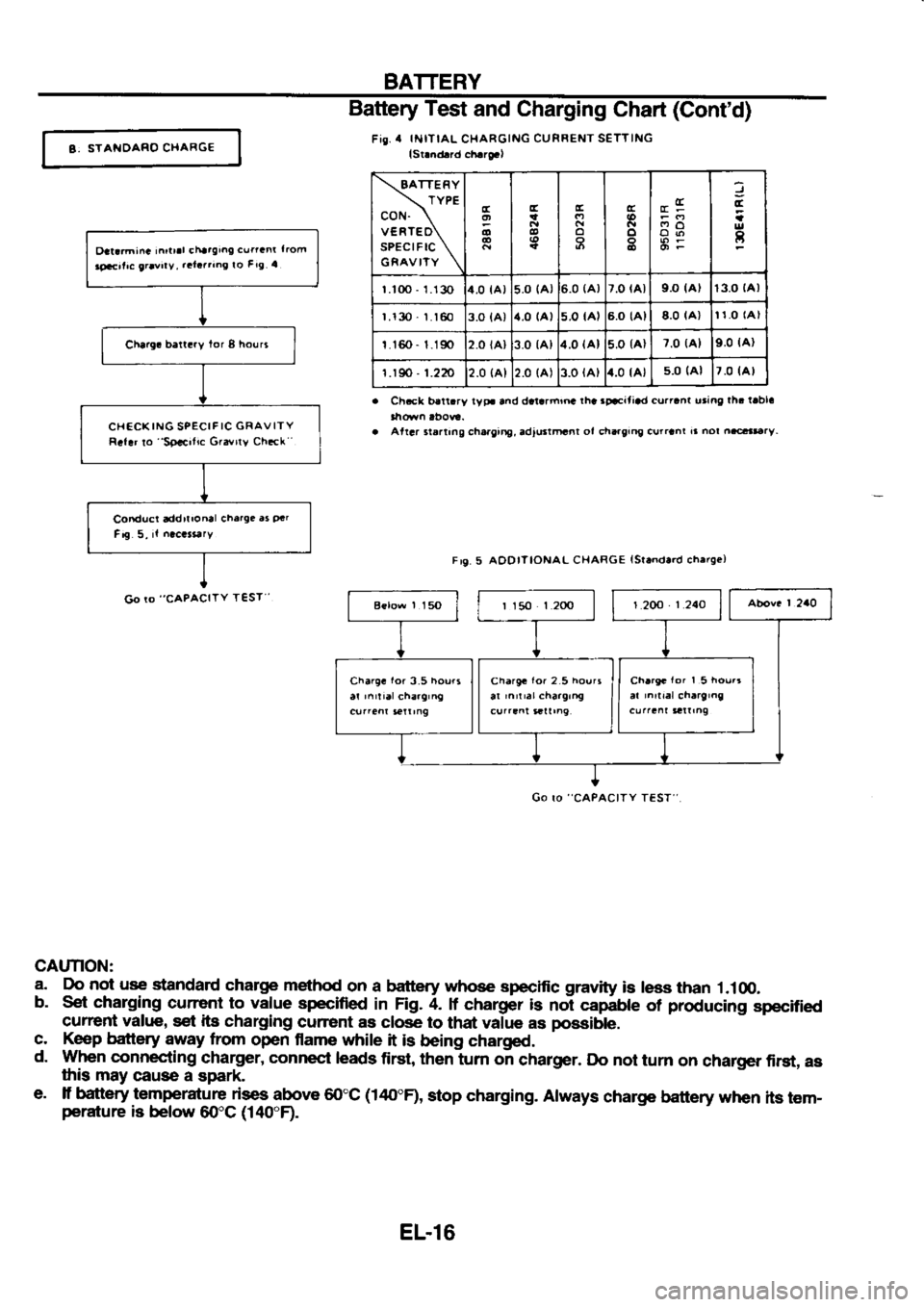
BATTERY
A. STANOARO CHARGE Battery
Test
and Charging
Chart (Cont'd)
Fis.4 lNtTlAL
CHARGING CURRENT
SETTING
lst.nd.rd ch.rerl
\BATTERY TYPE
coN. \
V€RTEO\
SPEC|FTC \
GRAVITY \o
o c
I
r.1m -
1.130 4.0 tAt 5.0 {A) 6.0
{At 7.O
tAl 9.O (a)
13.O tAl
1.130 -
1.160 3.O {At 1.0
tAt 5.0
{Al 6.0
tAt 8.0 (A)
l r.o
tal
r.160 -
1.1$ 2.0
la) 3.0
{At 4.0 (a)
5.0 {At 7.0 (Al
LO {A)
1.r 90 -
1.220 2.0 (Al
2.0 (a)
3.0 tA) r.0
tA, s.0 (al
7.0 (At
Ch.ck b.tr.ry typ. 5nd dct.rmrn. rh..rifiad
cu.r.nr rrint th.
i.bl.
Altcr 3iarlrng cha.girE, adiu.tmGnt ol
ch.rging cur.ant r.
nol n.odta.Y.
CAUTION:
a. Do not use
standard charge method
on a battery whose
specific gravity
is less
than 1.100.
b. Set charging
current to value
specified in Fig.4.
It charger is
not capabte
of producing
specified
current value,
set its
charging current as close to
that value as possible.
c. Keep bdtery
away from
open flame
while it
is being charged.
d. When
connecting charger, conneci
leads lirst, then
tum on
charger. Do not
turn on charger first,
as
this may
cause a
spark.
e. lf battery
temperature rises
above 6O"C (lril)"D,
stop charging.
Always charge battery when
its tem-
perature is below 60"C (140"D.
Oatarhina
ihit|.l charging curranl t.om
rp.citrc gr.vity.
rcl.rri.9
lo F19.
4
Cha.g. b.ttrry lor
S hou13
CTIECK ING
SPECIFIC GRAVITY
R.t.r ro "Spacitrc
Gravny Ch.ck"
Cor€uct addrt|onal charg?.3
Pcr
Fq 5, it nccgrary
Go ro
"CAPACITY TEST ' Fr9.
5 AODIIIONAL CHARGE {Stt^d..d
charg.)
r 150 I
200
Ch.rgr ro.
l Shou.t
er Inrtr.l
ch.rtrng
Chargc
tor
3.5 hours
el rnrtial
charg,ng Chargc
lor
2.5 houri
Go Io .,cAPAcITY
TEST''
EL.l6
Page 1128 of 1254
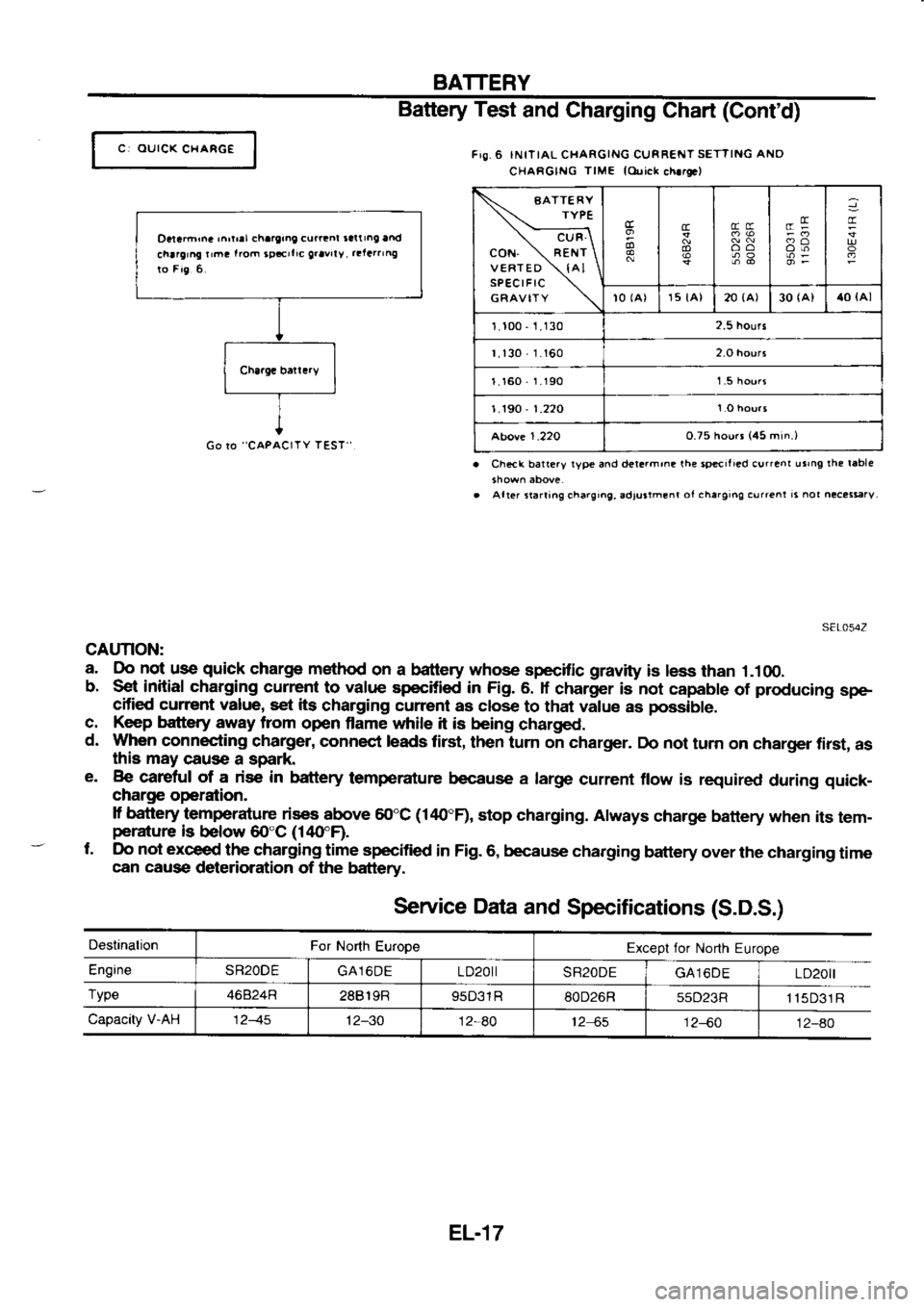
BATTERY
C OUICK
CHAFGE
CAUTION:
a. b.
c.
d. Oo
not
use quick
charge method on a bdtery whose
specific gravity
is les.s
than 1.10O.
s€t initial charging
curent to valr.p
specified in
Fig. 6. lf
charger is not
capable of producing
spe
cified current value,
set its
charging current
as close
to that value
as possible.
Keep battery
away from
open llame while it
is being
charged.
When connecting charger, connect leads
tirst, then tum on charger.
Do not
turn on charger
tirst, as
this may
caus€ a spark.
e. 8e
careful of a rise in
battery temperature because a large
current flow is
required during quick-
charge operation.
lf battery
temperaturc rises
above 6O"C (1.10"D,
stop charging. Always
charge battery when its
tem-
perature is below 6O"C (lrO'D.
f. Do not exceed
the chargin-g
time specilied
in Fig. 6, because
charging battery over the charging
time
can cause
deterioration of the battery.
Service Data
and Specifications (S.D.S.)
Destination For North
Europe
Excepl for
North Europe
Engine SR2ODEGA16DE LD20tlSR2ODE
GA16DE LD20rl
Type 46824R
28819R95D31R 80D26R55D23R1 15D31
R
Capacity V-AH 1245
12-30'12-80
't245
12-60 12-aO
Oaarrhina
r^rt.l
chargrng curr!.1 lattrn9
and
chrrgrng rrmc lrom
tp.crfic g.avrly,
rltlrrrng
ro Frg 6
Go ro "CAPACITY
TEST" Battery
Test and Charging
Chart (Cont'd)
Frs. 6 lNtTlALCHARGING CURRENTSETTING ANo
CHARGI G TIME
lorick chrrg.)
1 BATTE
RY
\ TYPE
\\--
cuR
\
coN. RENr
VERTED \AI
SPECTFTC \
GRAVITY \c!
(!
cD iIC!
oo _t
3? E
10 tAl 15
lA) 20 (A)
30 (a)
40 (a)
1 100 -
1.130 2.5
hour3
r. r30 .
1. t60 2.O
hour3
1.160 -
r .190
1.190 -
1.220
Above 1.220
O.75 houri (45
mi^.)
Ch.ck bartery typ€ and detcrmrn? th€
speciljed current utrng the
lable
alrer rrarr'n9 cha.grh9, adturih?.t ol
chargrng curr€^l r3
nor nacargfv
EL.17
Page 1129 of 1254
![NISSAN SERENA 1993 Service Repair Manual STARTING
SYSTEM
Wiring Diagram
@ clreor
engine mocJe
s
fi) e..pt
@
I
@;
615)o (cl0)[r
n
[-r]
E
/:;- , 1 l
!.&_r !
tr Ll
ii
ad) 6i
{pT
.)-l- @
.:^r
i
!@.,
5TAFI:Ii
|]c r0R
UNJ
f _]
E
F NISSAN SERENA 1993 Service Repair Manual STARTING
SYSTEM
Wiring Diagram
@ clreor
engine mocJe
s
fi) e..pt
@
I
@;
615)o (cl0)[r
n
[-r]
E
/:;- , 1 l
!.&_r !
tr Ll
ii
ad) 6i
{pT
.)-l- @
.:^r
i
!@.,
5TAFI:Ii
|]c r0R
UNJ
f _]
E
F](/img/5/57387/w960_57387-1128.png)
STARTING
SYSTEM
Wiring Diagram
@ clreor
engine mocJe
s
fi) e'..pt
@
I
@;
615)o (cl0)[r
n
[-r]
E
/:;- , 1 l
!.&_r !
tr Ll
ii
ad) 6i
{pT
.)-l- @
.:^r
i
!@.,
5TAFI:Ii
|]c r0R
UNJ
f _]
E
F.]:I BLT LiNK AND /.i \,
FUSE EOX !::]-/
EL-18
Page 1130 of 1254
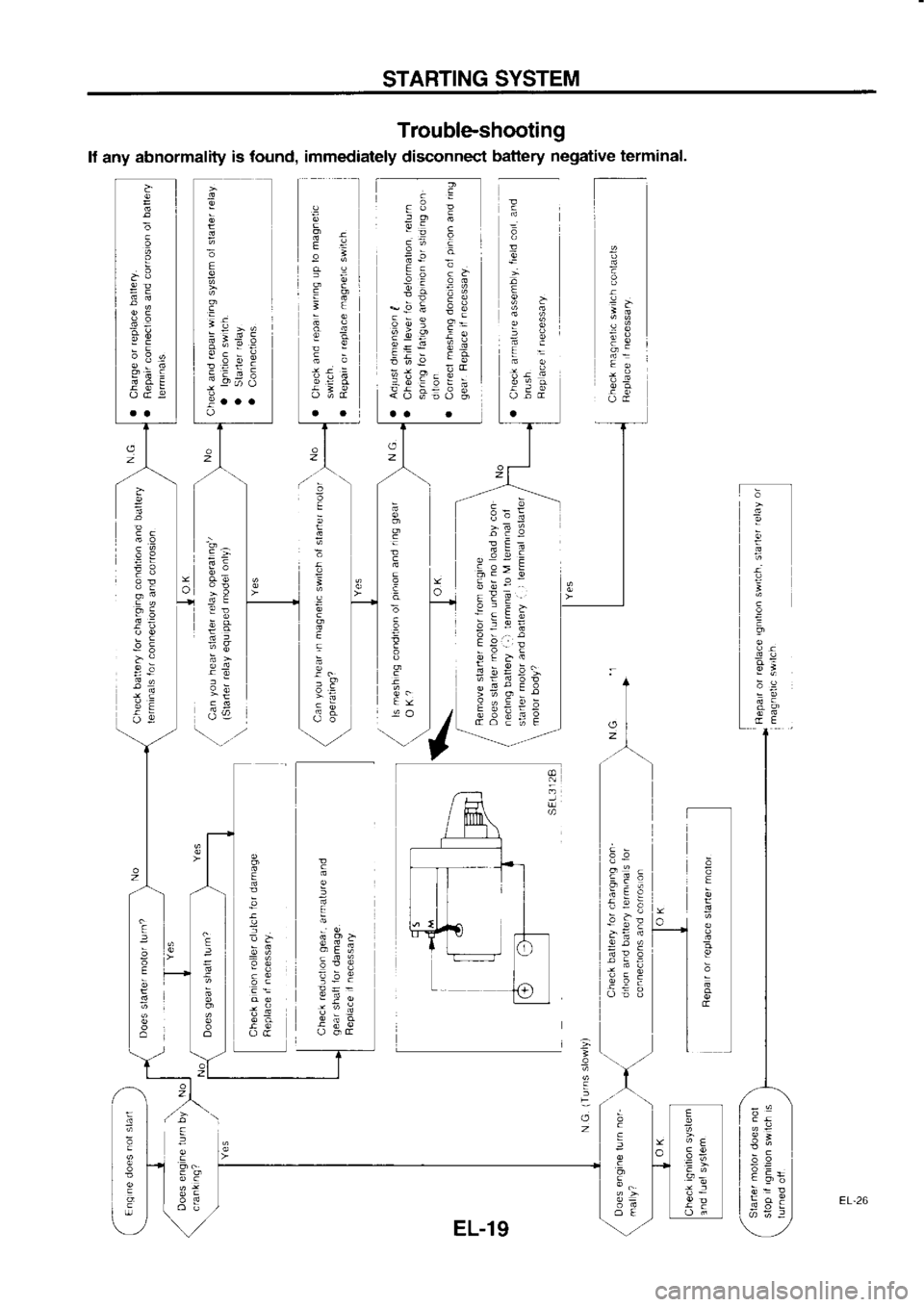
STARTING
SYSTEM
Trouble-shooting
lf any abnormality is
found, immediately disconnect battery negative
terminal.
I
a
ih
eB
EO
o
I
e
E
g>
:; io
L'l;ct
s3
!
lo h
96 E
;r; q-_
;-9: qi"
55; E
e
Eis.E:
E 5 s= 3 s
!
6
E E
q
::
6 3+
b
d b; l
Coo.
!!
99
s
E
>E
f
. EEE
1e= F
.p6.
e!;9. 99dgP
E
6 i
i;
Oo
E
qF;
O 5(!
;9
!.
iq
;;>i
E
-
:
I
I
q
d
E
2
6 E
o
I
-
69
€9
=2
O9
E
-9 o
cr
9;
P
j
6
-9
-
o
2 q
og
o-
-
b q
I
H: -E
a 39
9: F
o(Ig
E a
9
I
6 9
3
i E
EL-l9